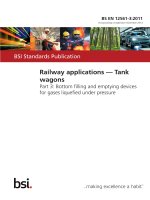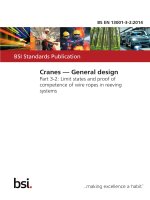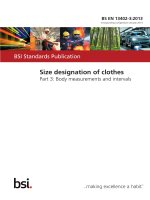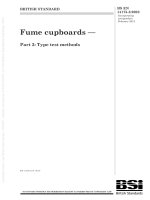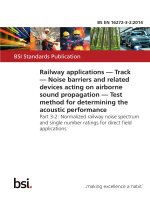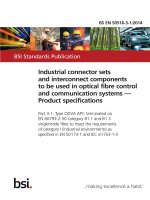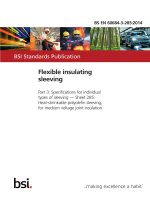Bsi bs en 61158 3 13 2014
Bạn đang xem bản rút gọn của tài liệu. Xem và tải ngay bản đầy đủ của tài liệu tại đây (1.92 MB, 50 trang )
BS EN 61158-3-13:2014
BSI Standards Publication
Industrial communication
networks — Fieldbus
specifications
Part 3-13: Data-link layer service
definition — Type 13 elements
BRITISH STANDARD
BS EN 61158-3-13:2014
National foreword
This British Standard is the UK implementation of EN 61158-3-13:2014. It is
identical to IEC 61158-3-13:2014. It supersedes BS EN 61158-3-13:2008
which is withdrawn.
The UK participation in its preparation was entrusted to Technical Committee AMT/7, Industrial communications: process measurement and
control, including fieldbus.
A list of organizations represented on this committee can be obtained on
request to its secretary.
This publication does not purport to include all the necessary provisions of
a contract. Users are responsible for its correct application.
© The British Standards Institution 2014.
Published by BSI Standards Limited 2014
ISBN 978 0 580 79366 0
ICS 25.040.40; 35.100.20; 35.240.50
Compliance with a British Standard cannot confer immunity from
legal obligations.
This British Standard was published under the authority of the
Standards Policy and Strategy Committee on 31 October 2014.
Amendments/corrigenda issued since publication
Date
Text affected
BS EN 61158-3-13:2014
EUROPEAN STANDARD
EN 61158-3-13
NORME EUROPÉENNE
EUROPÄISCHE NORM
October 2014
ICS 25.040.40; 35.100.20; 35.110
Supersedes EN 61158-3-13:2008
English Version
Industrial communication networks - Fieldbus specifications Part 3-13: Data-link layer service definition - Type 13 elements
(IEC 61158-3-13:2014)
Réseaux de communication industriels - Spécifications des
bus de terrain - Partie 3-13: Définition des services de la
couche liaison de données - Eléments de type 13
(CEI 61158-3-13:2014)
Industrielle Kommunikationsnetze - Feldbusse - Teil 3-13:
Dienstfestlegungen des Data Link Layer
(Sicherungsschicht) - Typ 13-Elemente
(IEC 61158-3-13:2014)
This European Standard was approved by CENELEC on 2014-09-17. CENELEC members are bound to comply with the CEN/CENELEC
Internal Regulations which stipulate the conditions for giving this European Standard the status of a national standard without any alteration.
Up-to-date lists and bibliographical references concerning such national standards may be obtained on application to the CEN-CENELEC
Management Centre or to any CENELEC member.
This European Standard exists in three official versions (English, French, German). A version in any other language made by translation
under the responsibility of a CENELEC member into its own language and notified to the CEN-CENELEC Management Centre has the
same status as the official versions.
CENELEC members are the national electrotechnical committees of Austria, Belgium, Bulgaria, Croatia, Cyprus, the Czech Republic,
Denmark, Estonia, Finland, Former Yugoslav Republic of Macedonia, France, Germany, Greece, Hungary, Iceland, Ireland, Italy, Latvia,
Lithuania, Luxembourg, Malta, the Netherlands, Norway, Poland, Portugal, Romania, Slovakia, Slovenia, Spain, Sweden, Switzerland,
Turkey and the United Kingdom.
European Committee for Electrotechnical Standardization
Comité Européen de Normalisation Electrotechnique
Europäisches Komitee für Elektrotechnische Normung
CEN-CENELEC Management Centre: Avenue Marnix 17, B-1000 Brussels
© 2014 CENELEC All rights of exploitation in any form and by any means reserved worldwide for CENELEC Members.
Ref. No. EN 61158-3-13:2014 E
BS EN 61158-3-13:2014
EN 61158-3-13:2014
-2-
Foreword
The text of document 65C/759/FDIS, future edition 2 of IEC 61158-3-13, prepared by SC 65C
"Industrial networks" of IEC/TC 65 "Industrial-process measurement, control and automation" was
submitted to the IEC-CENELEC parallel vote and approved by CENELEC as EN 61158-3-13:2014.
The following dates are fixed:
•
latest date by which the document has to be implemented at
national level by publication of an identical national
standard or by endorsement
(dop)
2015-06-17
•
latest date by which the national standards conflicting with
the document have to be withdrawn
(dow)
2017-09-17
This document supersedes EN 61158-3-13:2008.
Attention is drawn to the possibility that some of the elements of this document may be the subject of
patent rights. CENELEC [and/or CEN] shall not be held responsible for identifying any or all such
patent rights.
This document has been prepared under a mandate given to CENELEC by the European Commission
and the European Free Trade Association.
Endorsement notice
The text of the International Standard IEC 61158-3-13:2014 was approved by CENELEC as a
European Standard without any modification.
In the official version, for Bibliography, the following notes have to be added for the standards indicated:
IEC 61158-1
NOTE
Harmonized as EN 61158-1.
IEC 61158-6-13
NOTE
Harmonized as EN 61158-6-13.
IEC 61784-2
NOTE
Harmonized as EN 61784-2.
-3-
BS EN 61158-3-13:2014
EN 61158-3-13:2014
Annex ZA
(normative)
Normative references to international publications
with their corresponding European publications
The following documents, in whole or in part, are normatively referenced in this document and are
indispensable for its application. For dated references, only the edition cited applies. For undated
references, the latest edition of the referenced document (including any amendments) applies.
NOTE 1
When an International Publication has been modified by common modifications, indicated by (mod),
the relevant EN/HD applies.
NOTE 2
Up-to-date information on the latest versions of the European Standards listed in this annex is
available here: www.cenelec.eu.
Publication
Year
Title
EN/HD
Year
IEC 61158-4-13
2014
Industrial communication networks - Fieldbus
specifications Part 4-13: Data-link layer protocol
specification - Type 13 elements
EN 61158-4-13
1)
IEC 61158-5-13
2014
Industrial communication networks - Fieldbus
specifications Part 5-13: Application layer service
definition - Type 13 elements
EN 61158-5-13
2014
ISO/IEC 7498-1
-
Information technology - Open Systems
Interconnection - Basic Reference Model:
The Basic Model
-
-
ISO/IEC 7498-3
-
Information technology - Open Systems
Interconnection - Basic Reference Model:
Naming and addressing
-
-
ISO/IEC 8802-3
2000
Information technology Telecommunications and information
exchange between systems - Local and
metropolitan area networks - Specific
requirements Part 3: Carrier sense multiple access with
collision detection (CSMA/CD) access
method and physical layer specifications
-
-
ISO/IEC 10731
-
Information technology - Open Systems
Interconnection - Basic Reference Model Conventions for the definition of OSI services
-
-
IETF RFC 768
-
User Datagram Protocol
-
-
IETF RFC 791
-
Internet Protocol
-
-
IETF RFC 793
-
Transmission Control Protocol
-
-
1)
To be published.
–2–
BS EN 61158-3-13:2014
IEC 61158-3-13:2014 © IEC 2014
CONTENTS
INTRODUCTION ..................................................................................................................... 6
1
Scope ............................................................................................................................... 7
2
1.1 General ................................................................................................................... 7
1.2 Specifications .......................................................................................................... 7
1.3 Conformance ........................................................................................................... 7
Normative references ....................................................................................................... 8
3
Terms, definitions, symbols, abbreviations and conventions ............................................. 8
4
3.1 Reference model terms and definitions .................................................................... 8
3.2 Service convention terms and definitions ............................................................... 10
3.3 Data-link service terms and definitions .................................................................. 11
3.4 Symbols and abbreviations .................................................................................... 15
3.5 Common conventions ............................................................................................ 16
3.6 Additional Type 13 conventions ............................................................................. 17
Data-link service and concept ......................................................................................... 18
5
4.1 Overview ............................................................................................................... 18
4.2 Detailed description of isochronous-data services ................................................. 27
4.3 Detailed description of asynchronous-data service ................................................ 28
4.4 Detailed description of exception-signaling services .............................................. 35
4.5 NMT-status services .............................................................................................. 37
Data-link management services (and concepts) .............................................................. 38
5.1 General ................................................................................................................. 38
5.2 Facilities of the DLMS ........................................................................................... 38
5.3 Services of the DL-management ............................................................................ 38
5.4 Overview of interactions ........................................................................................ 39
5.5 Detail specification of service and interactions ...................................................... 40
Bibliography .......................................................................................................................... 45
Figure 1 – Relationships of DLSAPs, DLSAP-addresses and group DL-addresses ................ 13
Figure 2 – Type 13 communication architecture .................................................................... 18
Figure 3 – Sequence diagram of isochronous-data service ................................................... 19
Figure 4 – Sequence diagram of service-data service ........................................................... 20
Figure 5 – Sequence diagram of an unspecified-data transfer service ................................... 21
Figure 6 – Sequence diagram of a status-data transfer service ............................................. 21
Figure 7 – Sequence diagram of an ident-data transfer service ............................................. 22
Figure 8 – Sequence diagram of a sync-data transfer service ............................................... 23
Figure 9 – Sequence diagram of an NMT-command transfer service ..................................... 24
Figure 10 – Sequence diagram of an exception-signaling service ......................................... 25
Figure 11 – Sequence diagram of a NMT-status transfer service .......................................... 26
Figure 12 – Reset, Set value and Get value services ............................................................ 39
Figure 13 – Event and Frame status service ......................................................................... 40
Table 1 – Type 13 node ID assignment ................................................................................. 27
Table 2 – Primitives and parameters used on the isochronous data service .......................... 27
BS EN 61158-3-13:2014
IEC 61158-3-13:2014 © IEC 2014
–3–
Table 3 – Transmit /Receive isochronous-data primitives and the parameters ....................... 28
Table 4 – Primitives and parameters used on service data transfer service ........................... 28
Table 5 – Transmit / Receive service-data primitives and the parameters ............................. 29
Table 6 – Primitives and parameters used on the unspecified-data service ........................... 30
Table 7 – Transmit / receive unspecified-data primitives and the parameters ........................ 30
Table 8 – Primitives and parameters used on status-data transfer service ............................ 31
Table 9 – Status data primitives and the parameters ............................................................. 31
Table 10 – Primitives and parameters used on ident-data transfer service ............................ 32
Table 11 – Ident data primitives and the parameters ............................................................. 33
Table 12 – Primitives and parameters used on sync-data transfer service............................. 33
Table 13 – Sync data primitives and the parameters ............................................................. 34
Table 14 – Primitives and parameters used on the NMT-command service ........................... 34
Table 15 – NMT-command primitives and the parameters ..................................................... 35
Table 16 – Primitives and parameters used on the exception-signaling service ..................... 35
Table 17 – Exception-signaling initialization primitives and the parameters ........................... 36
Table 18 – Exception signaling initialization primitives and the parameters ........................... 36
Table 19 – Primitives and parameters used on the NMT-status service ................................. 37
Table 20 – NMT-status primitives and the parameters........................................................... 37
Table 21 – Summary of DL-management primitives and parameters ..................................... 39
Table 22 – DLM-Reset primitives and parameters ................................................................. 40
Table 23 – DLM-Set-value primitives and parameters ........................................................... 41
Table 24 – DLM-Get-value primitives and parameters ........................................................... 42
Table 25 – Event primitives and parameters ......................................................................... 42
Table 26 – Event-related state change variables ................................................................... 43
Table 27 – Frame status primitives and parameters .............................................................. 43
Table 28 – Frame parameters ............................................................................................... 44
–6–
BS EN 61158-3-13:2014
IEC 61158-3-13:2014 © IEC 2014
INTRODUCTION
This part of IEC 61158 is one of a series produced to facilitate the interconnection of
automation system components. It is related to other standards in the set as defined by the
“three-layer” fieldbus reference model described in IEC 61158-1.
Throughout the set of fieldbus standards, the term “service” refers to the abstract capability
provided by one layer of the OSI Basic Reference Model to the layer immediately above.
Thus, the data-link layer service defined in this standard is a conceptual architectural service,
independent of administrative and implementation divisions.
BS EN 61158-3-13:2014
IEC 61158-3-13:2014 © IEC 2014
–7–
INDUSTRIAL COMMUNICATION NETWORKS –
FIELDBUS SPECIFICATIONS –
Part 3-13: Data-link layer service definition –
Type 13 elements
1
1.1
Scope
General
This part of IEC 61158 provides common elements for basic time-critical messaging
communications between devices in an automation environment. The term “time-critical” is
used to represent the presence of a time-window, within which one or more specified actions
are required to be completed with some defined level of certainty. Failure to complete
specified actions within the time window risks failure of the applications requesting the
actions, with attendant risk to equipment, plant and possibly human life.
This standard defines in an abstract way the externally visible service provided by the
Type 13 fieldbus data-link layer in terms of
a) the primitive actions and events of the service;
b) the parameters associated with each primitive action and event, and the form which they
take; and
c) the interrelationship between these actions and events, and their valid sequences.
The purpose of this standard is to define the services provided to
•
the Type 13 fieldbus application layer at the boundary between the application and datalink layers of the fieldbus reference model, and
•
systems management at the boundary between the data-link layer and systems
management of the fieldbus reference model.
1.2
Specifications
The principal objective of this standard is to specify the characteristics of conceptual data-link
layer services suitable for time-critical communications, and thus supplement the OSI Basic
Reference Model in guiding the development of data-link protocols for time-critical
communications. A secondary objective is to provide migration paths from previously-existing
industrial communications protocols.
This specification may be used as the basis for formal DL-Programming-Interfaces.
Nevertheless, it is not a formal programming interface, and any such interface will need to
address implementation issues not covered by this specification, including
a) the sizes and octet ordering of various multi-octet service parameters, and
b) the correlation of paired request and confirm, or indication and response, primitives.
1.3
Conformance
This standard does not specify individual implementations or products, nor do they constrain
the implementations of data-link entities within industrial automation systems.
There is no conformance of equipment to this data-link layer service definition standard.
Instead, conformance is achieved through implementation of the corresponding data-link
protocol that fulfills the Type 13 data-link layer services defined in this standard.
–8–
2
BS EN 61158-3-13:2014
IEC 61158-3-13:2014 © IEC 2014
Normative references
The following documents, in whole or in part, are normatively referenced in this document and
are indispensable for its application. For dated references, only the edition cited applies. For
undated references, the latest edition of the referenced document (including any
amendments) applies.
NOTE All parts of the IEC 61158 series, as well as IEC 61784-1 and IEC 61784-2 are maintained simultaneously.
Cross-references to these documents within the text therefore refer to the editions as dated in this list of normative
references.
IEC 61158-4-13:2014, Industrial communication networks – Fieldbus
Part 4-13: Data-link layer protocol specification – Type 13 elements
specifications
–
IEC 61158-5-13:2014, Industrial communication networks – Fieldbus
Part 5-13: Application layer service definition – Type 13 elements
specifications
–
ISO/IEC 7498-1, Information technology – Open Systems Interconnection – Basic Reference
Model: The Basic Model
ISO/IEC 7498-3, Information technology – Open Systems Interconnection – Basic Reference
Model: Naming and addressing
ISO/IEC 8802-3:2000, Information technology – Telecommunications and information
exchange between systems – Local and metropolitan area networks – Specific requirements –
Part 3: Carrier sense multiple access with collision detection (CSMA/CD) access method and
physical layer specifications
ISO/IEC 10731, Information technology – Open Systems Interconnection – Basic Reference
Model – Conventions for the definition of OSI services
IETF RFC 768, User Datagram Protocol; available at <>
IETF RFC 791, Internet Protocol; available at <>
IETF RFC 793, Transmission Control Protocol; available at <>
3
Terms, definitions, symbols, abbreviations and conventions
For the purposes of this document, the following terms, definitions, symbols, abbreviations
and conventions apply.
3.1
Reference model terms and definitions
This standard is based in part on the concepts developed in ISO/IEC 7498-1 and
ISO/IEC 7498-3, and makes use of the following terms defined therein:
3.1.1
DL-address
[7498-3]
3.1.2
DL-address-mapping
[7498-1]
3.1.3
called-DL-address
[7498-3]
3.1.4
calling-DL-address
[7498-3]
3.1.5
centralized multi-end-point-connection
[7498-1]
BS EN 61158-3-13:2014
IEC 61158-3-13:2014 © IEC 2014
–9–
3.1.6
DL-connection
[7498-1]
3.1.7
DL-connection-end-point
[7498-1]
3.1.8
DL-connection-end-point-identifier
[7498-1]
3.1.9
DL-connection-mode transmission
[7498-1]
3.1.10
DL-connectionless-mode transmission
[7498-1]
3.1.11
correspondent (N)-entities
correspondent DL-entities (N=2)
correspondent Ph-entities (N=1)
[7498-1]
3.1.12
DL-duplex-transmission
[7498-1]
3.1.13
(N)-entity
DL-entity (N=2)
Ph-entity (N=1)
[7498-1]
3.1.14
DL-facility
[7498-1]
3.1.15
flow control
[7498-1]
3.1.16
(N)-layer
DL-layer (N=2)
Ph-layer (N=1)
[7498-1]
3.1.17
layer-management
[7498-1]
3.1.18
DL-local-view
[7498-3]
3.1.19
DL-name
[7498-3]
3.1.20
naming-(addressing)-domain
[7498-3]
3.1.21
peer-entities
[7498-1]
3.1.22
primitive name
[7498-3]
3.1.23
DL-protocol
[7498-1]
3.1.24
DL-protocol-connection-identifier
[7498-1]
3.1.25
DL-protocol-data-unit
[7498-1]
3.1.26
DL-relay
[7498-1]
3.1.27
reset
[7498-1]
3.1.28
responding-DL-address
[7498-3]
3.1.29
routing
[7498-1]
3.1.30
segmenting
[7498-1]
3.1.31
(N)-service
DL-service (N=2)
Ph-service (N=1)
[7498-1]
3.1.32
(N)-service-access-point
DL-service-access-point (N=2)
Ph-service-access-point (N=1)
[7498-1]
– 10 –
BS EN 61158-3-13:2014
IEC 61158-3-13:2014 © IEC 2014
3.1.33
DL-service-access-point-address
[7498-3]
3.1.34
DL-service-connection-identifier
[7498-1]
3.1.35
DL-service-data-unit
[7498-1]
3.1.36
DL-simplex-transmission
[7498-1]
3.1.37
DL-subsystem
[7498-1]
3.1.38
systems-management
[7498-1]
3.1.39
DLS-user-data
[7498-1]
3.2
Service convention terms and definitions
This standard also makes use of the following terms defined in ISO/IEC 10731 as they apply
to the data-link layer:
BS EN 61158-3-13:2014
IEC 61158-3-13:2014 © IEC 2014
– 11 –
3.2.1
acceptor
3.2.2
asymmetrical service
3.2.3
confirm (primitive);
requestor.deliver (primitive)
3.2.4
deliver (primitive)
3.2.5
DL-confirmed-facility
3.2.6
DL-facility
3.2.7
DL-local-view
3.2.8
DL-mandatory-facility
3.2.9
DL-non-confirmed-facility
3.2.10
DL-provider-initiated-facility
3.2.11
DL-provider-optional-facility
3.2.12
DL-service-primitive;
primitive
3.2.13
DL-service-provider
3.2.14
DL-service-user
3.2.15
DLS-user-optional-facility
3.2.16
indication (primitive);
acceptor.deliver (primitive)
3.2.17
multi-peer
3.2.18
request (primitive);
requestor.submit (primitive)
3.2.19
requestor
3.2.20
response (primitive);
acceptor.submit (primitive)
3.2.21
submit (primitive)
3.2.22
symmetrical service
3.3
Data-link service terms and definitions
For the purposes of this document, the following terms and definitions apply.
3.3.1
application process
application layer task
3.3.2
async-only CN
CN that is accessed only by polling
– 12 –
BS EN 61158-3-13:2014
IEC 61158-3-13:2014 © IEC 2014
3.3.3
asynchronous period
second part of the Type 13 cycle, starting with a start of asynchronous (SoA) frame
3.3.4
basic Ethernet mode
mode that provides legacy Ethernet communication
3.3.5
continuous-time-triggered
communication class where isochronous communication takes place every cycle
Note 1 to entry: The data sent from MN to various CNs are packed into a PollResponse. No PollRequest to these
CNs is necessary. The CNs send their PollResponse time triggered. (An alternative to continuous).
Note 2 to entry: There are three node classes: continuous, multiplexed and continuous-time-triggered. Each node
is a member of exactly one of these classes.
3.3.6
continuous
communication class where isochronous communication takes place every cycle (the opposite
to multiplexed)
Note 1 to entry: There are three node classes: continuous, multiplexed and continuous-time-triggered. Each node
is a member of exactly one of these classes.
3.3.7
controlled node
network node without the ability to manage the SCNM mechanism
3.3.8
cycle time
time between two consecutive start of cyclic (SoC) frames
Note 1 to entry: The Cycle Time includes the time for data transmission and some idle time before the beginning
of the next cycle.
3.3.9
DLCEP-address
DL-address which designates either
a) one peer DL-connection-end-point, or
b) one multi-peer publisher DL-connection-end-point and implicitly the corresponding set of
subscriber DL-connection-end-points where each DL-connection-end-point exists within a
distinct DLSAP and is associated with a corresponding distinct DLSAP-address
3.3.10
DL-segment,
link,
local link
single DL-subnetwork in which any of the connected DLEs may communicate directly, without
any intervening DL-relaying, whenever all of those DLEs that are participating in an instance
of communication are simultaneously attentive to the DL-subnetwork during the period(s) of
attempted communication
3.3.11
DLSAP
distinctive point at which DL-services are provided by a single DL-entity to a single higherlayer entity
BS EN 61158-3-13:2014
IEC 61158-3-13:2014 © IEC 2014
– 13 –
Note 1 to entry: This definition, derived from ISO/IEC 7498-1, is repeated here to facilitate understanding of the
critical distinction between DLSAPs and their DL-addresses.
3.3.12
DL(SAP)-address
either an individual DLSAP-address, designating a single DLSAP of a single DLS-user, or a
group DL-address potentially designating multiple DLSAPs, each of a single DLS-user.
Note 1 to entry: This terminology is chosen because ISO/IEC 7498-3 does not permit the use of the term DLSAPaddress to designate more than a single DLSAP at a single DLS-user.
3.3.13
(individual) DLSAP-address
DL-address that designates only one DLSAP within the extended link
Note 1 to entry:
A single DL-entity may have multiple DLSAP-addresses associated with a single DLSAP.
NOTE 1
DLSAPs and PhSAPs are depicted as ovals spanning the boundary between two adjacent layers.
NOTE 2
DL-addresses are depicted as designating small gaps (points of access) in the DLL portion of a DLSAP.
NOTE 3 A single DL-entity may have multiple DLSAP-addresses and group DL-addresses associated with a
single DLSAP.
Figure 1 – Relationships of DLSAPs, DLSAP-addresses and group DL-addresses
3.3.14
frame
denigrated synonym for DLPDU
3.3.15
isochronous data
th
data which is transmitted every cycle (or every n cycle in case of multiplexed isochronous
data)
– 14 –
BS EN 61158-3-13:2014
IEC 61158-3-13:2014 © IEC 2014
3.3.16
isochronous period
period within each cycle that offers deterministic operation through being reserved for the
exchange of (continuous or multiplexed) isochronous data
3.3.17
legacy Ethernet
Ethernet as standardized in ISO/IEC 8802-3 (non-deterministic operation in non-time-critical
environments)
3.3.18
managing node
node that can manage the SCNM mechanism
3.3.19
multiplexed
communication class where cyclic communication takes place in such a way that m nodes are
served in s cycles (an alternative to continuous)
Note 1 to entry: m=s=1 is a special case for multiplexed nodes, which behaves like continuous but is still
multiplexed. There are three node classes: continuous, multiplexed and continuous-time-triggered. Each node is a
member of exactly one of these classes.
3.3.20
multiplexed timeslot
timeslot assigned to multiplexed isochronous data and shared among multiple nodes
3.3.21
multipoint connection
connection from one node to many nodes
Note 1 to entry:
Multipoint connection allows data transfer from a single publisher to many subscriber nodes.
3.3.22
multi-peer DLC
centralized multi-end-point DL-connection offering DL-duplex-transmission between a single
distinguished DLS-user known as the publisher or publishing DLS-user, and a set of peer but
undistinguished DLS-users known collectively as the subscribers or subscribing DLS-users,
where the publishing DLS-user can send to the subscribing DLS-users as a group (but not
individually), and the subscribing DLS-users can send to the publishing DLS-user (but not to
each other).
3.3.23
NetTime
clock time of the MN as distributed to all CNs by the SoC frame
3.3.24
network management
management functions and services that perform network initialization, configuration and error
handling
3.3.25
node
single DL-entity as it appears on one local link
3.3.26
PollRequest
frame which is used in the isochronous part of a communications cycle
BS EN 61158-3-13:2014
IEC 61158-3-13:2014 © IEC 2014
– 15 –
3.3.27
PollResponse
frame which is used in the isochronous part of a communications cycle to respond to a
PollRequest frame
3.3.28
process data object
object for isochronous data exchange between nodes
3.3.29
protocol
convention about the data formats, time sequences, and error correction in the data exchange
of communication systems
3.3.30
receiving DLS-user
DL-service user that acts as a recipient of DLS-user-data
Note 1 to entry:
A DL-service user can be concurrently both a sending and receiving DLS-user.
3.3.31
sending DLS-user
DL-service user that acts as a source of DLS-user-data
3.3.32
service data object
object for asynchronous data exchange between nodes
3.3.33
slot communication network management
mechanism which ensures that there are no collisions during physical network access of any
of the networked nodes, thus providing deterministic communication via legacy Ethernet
3.3.34
network cycle
basic repeating fixed interval of data exchange within a network that is subdivided into an
isochronous and an asynchronous period and is organized by the MN
3.3.35
node ID
single-octet node DL-address used by the Type 13 DL-protocol
3.4
Symbols and abbreviations
ASnd
Asynchronous send (Type 13 frame type)
CN
Controlled node
DL-
Data-link layer (as a prefix)
DLC
DL-connection
DLCEP
DL-connection-end-point
DLE
DL-entity (the local active instance of the data-link layer)
DLL
DL-layer
DLPCI
DL-protocol-control-information
– 16 –
BS EN 61158-3-13:2014
IEC 61158-3-13:2014 © IEC 2014
DLPDU
DL-protocol-data-unit
DLM
DL-management
DLME
DL-management entity (the local active instance of DL-management)
DLMS
DL-management service
DLS
DL-service
DLSAP
DL-service-access-point
DLSDU
DL-service-data-unit
FIFO
First-in first-out (queuing method)
MN
Managing node
NMT
Network management
OSI
Open systems interconnection
PDO
Process data object
Ph-
Physical layer (as a prefix)
PhE
Ph-entity (the local active instance of the physical layer)
PhL
Ph-layer
PReq
PollRequest (Type 13 frame type)
PRes
PollResponse (Type 13 frame type)
RTE
Real time Ethernet
SCNM
Slot communication network management
SDO
Service data object
SoA
Start of asynchronous (Type 13 frame type)
SoC
Start of cyclic (Type 13 frame type)
UDT
Unspecified-data transfer
3.5
Common conventions
This standard uses the descriptive conventions given in ISO/IEC 10731.
The service model, service primitives, and time-sequence diagrams used are entirely abstract
descriptions; they do not represent a specification for implementation.
Service primitives, used to represent service user/service provider interactions (see
ISO/IEC 10731), convey parameters that indicate information available in the user/provider
interaction.
This standard uses a tabular format to describe the component parameters of the DLS
primitives. The parameters that apply to each group of DLS primitives are set out in tables
throughout the remainder of this standard. Each table consists of up to six columns,
containing the name of the service parameter, and a column each for those primitives and
parameter-transfer directions used by the DLS:
BS EN 61158-3-13:2014
IEC 61158-3-13:2014 â IEC 2014
17
ã
The request primitive’s input parameters;
•
The request primitive’s output parameters;
•
The indication primitive’s output parameters;
•
The response primitive’s input parameters; and
•
The confirm primitive’s output parameters.
NOTE The request, indication, response and confirm primitives are also known as requestor.submit,
acceptor.deliver, acceptor.submit, and requestor.deliver primitives, respectively (see ISO/IEC 10731).
One parameter (or part of it) is listed in each row of each table. Under the appropriate service
primitive columns, a code is used to specify the type of usage of the parameter on the
primitive and parameter direction specified in the column:
M
Parameter: mandatory for the primitive.
U
Parameter: a User option, and may or may not be provided depending on the dynamic
usage of the DLS-user. When not provided, a default value for the parameter is
assumed.
C
Parameter is conditional upon other parameters or upon the environment of the DLSuser.
(Blank)
Parameter is never present.
Some entries are further qualified by items in brackets. These may be
a) a parameter-specific constraint
(=) indicates that the parameter is semantically equivalent to the parameter in the service
primitive to its immediate left in the table.
b) an indication that some note applies to the entry
(n) indicates that the following note n contains additional information pertaining to the
parameter and its use.
In any particular interface, not all parameters need be explicitly stated. Some may be
implicitly associated with the DLSAP at which the primitive is issued.
In the diagrams which illustrate these interfaces, dashed lines indicate cause-and-effect or
time-sequence relationships, and wavy lines indicate that events are roughly
contemporaneous.
3.6
Additional Type 13 conventions
In the diagrams which illustrate the DLS and DLM interfaces, dashed lines indicate causeand-effect or time-sequence relationships between actions at different stations, while solid
lines with arrows indicate cause-and-effect time-sequence relationships which occur within
the DLE-provider at a single station.
The following notation, a shortened form of the primitive classes defined in 3.5, is used in the
figures and tables.
req
request primitive
ind
indication primitive
cnf
confirm primitive (confirmation)
res
Response primitive
BS EN 61158-3-13:2014
IEC 61158-3-13:2014 © IEC 2014
– 18 –
4
Data-link service and concept
4.1
Overview
The Type 13 services extend Ethernet according to ISO/IEC 8802-3 with mechanisms to
transfer data with predictable timing and precise synchronization. The communication
services support timing demands typical for high-performance automation and motion
applications. They do not change basic principles of ISO/IEC 8802-3, but extend it towards
RTE. Thus it is possible to leverage and continue to use any standard Ethernet silicon,
infrastructure component or test and measurement equipment like a network analyzer.
This standard specifies Type 13 communication services.
Application layer
Time-critical application
Regular ISO/IEC 8802-3
based applications
Object Dictionary
FTP / HTTP / TELNET etc.
Transport layer
RFC 768 (UDP) / RFC 793 (TCP)
Network layer
RFC 791 (IP)
Data-link layer
ISO/IEC 8802-3 Specific scheduling extension
Physical layer
ISO/IEC 8802-3
Figure 2 – Type 13 communication architecture
This standard specifies the data-link
ISO/IEC 8802-3-based data-link layer.
4.1.1
services that are the extension part of the
Types and classes of data-link layer service
A Type 13 data link layer provides the following services:
•
Isochronous-data transfer service to send and receive isochronous data.
NOTE 1
•
Isochronous data transfer service is typically used for the exchange of time critical data (real-time data).
Asynchronous-data transfer. Different message types are provided:
–
Service-data transfer to access the entries of the object dictionary.
–
Unspecified-data transfer to communicate via legacy Ethernet frames.
–
Status-data transfer for requesting the current status and detailed error information of
a node.
–
Ident-data transfer to identify inactive nodes and/or to query the identification data of a
node.
–
NMT-command transfer providing network management functions.
–
Sync-data transfer for configuration/synchronization of continuous-time-triggered CNs.
NOTE 2
Asynchronous data transfer is used for the exchange of non time-critical data.
•
Exception-signaling transfer: The CNs are able to signal exceptions to the MN.
•
NMT-status transfer providing network management data to all nodes.
All data transfers are unconfirmed, i.e. there is no confirmation that sent data has been
received. To maintain deterministic behavior, protecting the isochronous data is neither
necessary nor desired. Asynchronous data is to be protected by higher protocol layers.
BS EN 61158-3-13:2014
IEC 61158-3-13:2014 © IEC 2014
4.1.1.1
– 19 –
Primitive of the isochronous-data service
The sequence of primitives for the isochronous-data service is shown in Figure 3.
Publisher
DLS-user
Subscriber
DLE
DLE
DLS-user
DL-PDO.req
(DLSDU)
DLPDU
DL-PDO.ind
(DLSDU)
Figure 3 – Sequence diagram of isochronous-data service
The publisher DLS-user prepares a DLSDU for a single subscribed DLS-user, or for all
subscribed DLS-users. The DLSDU is passed to the local DLE via the DLS interface by
means of a DL-PDO request primitive. The DLE accepts the service request and tries to send
the data to the subscribed DLE or to all subscribed DLEs.
The receiving DLE(s) attempt to deliver the received DLSDU to the specified DLS-user(s).
There is no confirmation of correct receipt at the remote DLEs or of delivery to the intended
DLS-user(s); acknowledgements do not occur. When the DLSDU is transmitted, it reaches all
subscribed DLEs approximately concurrently (ignoring signal propagation delays). Each
addressed DLE that has received the data DLPDU error-free passes the DLSDU and
associated addressing information to the local DLS-user by means of a DL-PDO indication
primitive.
4.1.1.2
4.1.1.2.1
Primitive of the asynchronous-data service
Service-data service
The sequence of primitives for the service-data service is shown in Figure 4.
– 20 –
BS EN 61158-3-13:2014
IEC 61158-3-13:2014 © IEC 2014
Client
DLS-user
Server
DLE
DLE
DLS-user
DL-SDO.req
(DLSDU)
DLPDU
DL-SDO.ind
(DLSDU)
DL-SDO.res
(DLSDU)
DLPDU
DL-SDO.cnf
(DLSDU)
Figure 4 – Sequence diagram of service-data service
The client DLS-user prepares a DLSDU for the server DLS-user and passes it to the local
DLE (DL entity) as the DLSDU parameter of a DL-SDO request primitive. The client DLE
accepts the service request, forms an appropriate DLPDU containing the DLSDU, and tries to
send the DLPDU to the server DLE.
Upon receiving the data DLPDU error-free, the server DLE passes the DLSDU and associated
information to the local DLS-user by means of a DL-SDO indication primitive.
For acknowledgement and for upload purpose, the server prepares a DLSDU for the client
DLS-user and passes it to the local DLE as the DLSDU parameter of a DL-SDO response
primitive. The server DLE accepts the service response, forms an appropriate DLPDU
containing the DLSDU, and tries to send the DLPDU to the client DLE.
Upon receiving the acknowledge / upload data DLPDU error-free, the client DLE passes the
DLSDU and associated information to the local DLS-user by means of a DL-SDO confirmation
primitive.
As the Type 13 uses unconfirmed services on the data link layer, no time limit is checked
during the transfer.
4.1.1.2.2
Unspecified-data transfer
The sequence of primitives on unspecified-data transfer (UDT) is shown in Figure 5.
DL-UDT request and DL-UDT indication correspond to the MA_DATA request and MA_DATA
indication defined by ISO/IEC 8802-3 respectively.
BS EN 61158-3-13:2014
IEC 61158-3-13:2014 © IEC 2014
– 21 –
Local node
DLS-user
Remote node
DLE
DLE
DLS-user
DL-UDT.req
(DLSDU)
DLPDU
(PhPDU)
DL-UDT.ind
(DLSDU)
Figure 5 – Sequence diagram of an unspecified-data transfer service
4.1.1.2.3
Status-data transfer
The sequence of primitives on status-data transfer is shown in Figure 6.
Master
DLS-user
Slave
DLE
DLE
DLS-user
DL-STA.req
DLPDU
DL-STA.ind
DL-STA.res
Other
nodes
(DLSDU)
DLPDU
DL-STA.cnf
(DLSDU)
Figure 6 – Sequence diagram of a status-data transfer service
The master DLS-user requests a status-data frame from a slave node with a DL-STA request
primitive, requesting data from the remote DLS-user.
Upon receiving the data DLPDU error-free, the slave DLE forms a local DL-STA indication
primitive and passes it to the DLS-user. The slave DLS-user prepares a DLSDU for the
master DLS-user and passes it to the local DLE as the DLSDU parameter of a DL-STA
response primitive. The slave DLS-user is responsible for having prepared a valid DLSDU,
ready for transmission by the slave DLE.
– 22 –
BS EN 61158-3-13:2014
IEC 61158-3-13:2014 © IEC 2014
When a reply DLPDU is received by either the master DLS-user or any other node, the DLE
passes the conveyed DLSDU to the local DLS-user by means of a DL-STA confirmation
primitive.
As the Type 13 uses unconfirmed services on the data link layer, no time limit is checked
during the transfer.
4.1.1.2.4
Ident-data transfer
The sequence of primitives on ident-data transfer is shown in Figure 7.
Master
DLS-user
Slave
DLE
DLE
DLS-user
DL-IDE.req
DLPDU
DL-IDE.ind
DL-IDE.res
Other
nodes
(DLSDU)
DLPDU
DL.IDE cnf
(DLSDU)
Figure 7 – Sequence diagram of an ident-data transfer service
The master DLS-user requests a ident-data frame from a slave node with a DL-IDE request
primitive, requesting data from the remote DLS-user.
Upon receiving the data DLPDU error-free, the slave DLE forms a local DL-IDE indication
primitive and passes it to the DLS-user. The slave DLS-user prepares a DLSDU for the
master DLS-user and passes it to the local DLE as the DLSDU parameter of a DL-IDE
response primitive. The slave DLS-user is responsible for having prepared a valid DLSDU,
ready for transmission by the slave DLE.
When a reply DLPDU is received by either the master DLS-user or any other node, the DLE
passes the conveyed DLSDU to the local DLS-user by means of a DL-IDE indication primitive.
As Type 13 uses unconfirmed services on the data link layer, no time limit is checked during
the transfer.
4.1.1.2.5
Sync-data transfer
The sequence of primitives on sync-data transfer is shown in Figure 8.
BS EN 61158-3-13:2014
IEC 61158-3-13:2014 © IEC 2014
– 23 –
Master
DLS-user
Slave
DLE
DLE
DLS-user
DL-SYN.req
(DLSDU)
DLPDU
DL-SYN.ind
(DLSDU)
DL-SYN.res
Other
nodes
(DLSDU)
DLPDU
DL-SYN.cnf
(DLSDU)
Figure 8 – Sequence diagram of a sync-data transfer service
The master DLS-user requests a sync-data frame from a slave node with a DL-SYN request
primitive, sending data to and requesting data from the remote DLS-user.
Upon receiving the data DLPDU error-free, the slave DLE forms a local DL-SYN indication
primitive and passes it to the DLS-user. The slave DLS-user prepares a DLSDU for the
master DLS-user and passes it to the local DLE as the DLSDU parameter of a DL-SYN
response primitive. The slave DLS-user is responsible for having prepared a valid DLSDU,
ready for transmission by the slave DLE.
When a reply DLPDU is received by either the master DLS-user or any other node, the DLE
passes the conveyed DLSDU to the local DLS-user by means of a DL-SYN indication
primitive.
As Type 13 uses unconfirmed services on the data link layer, no time limit is checked during
the transfer.
